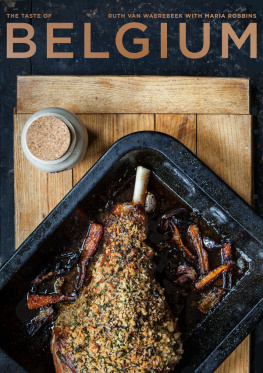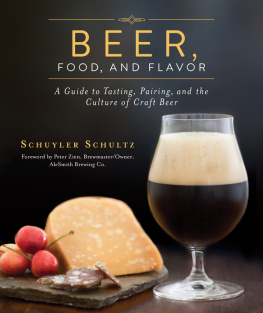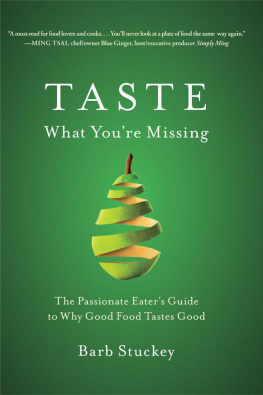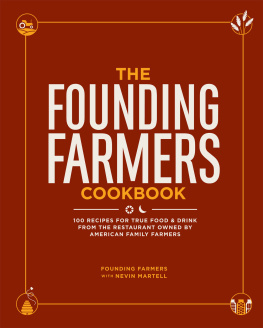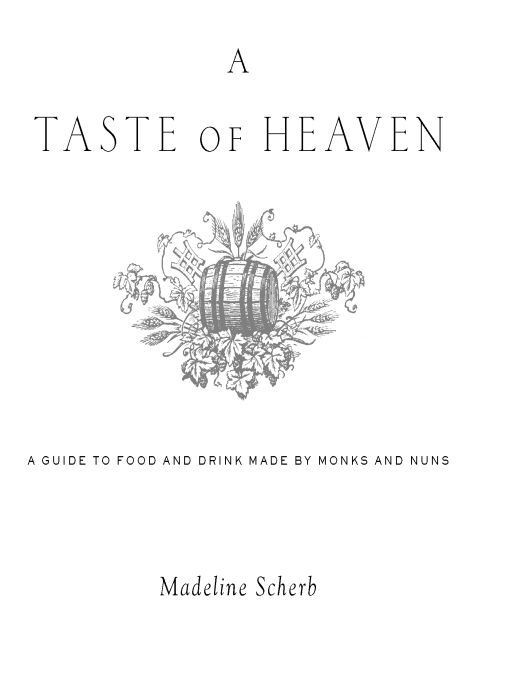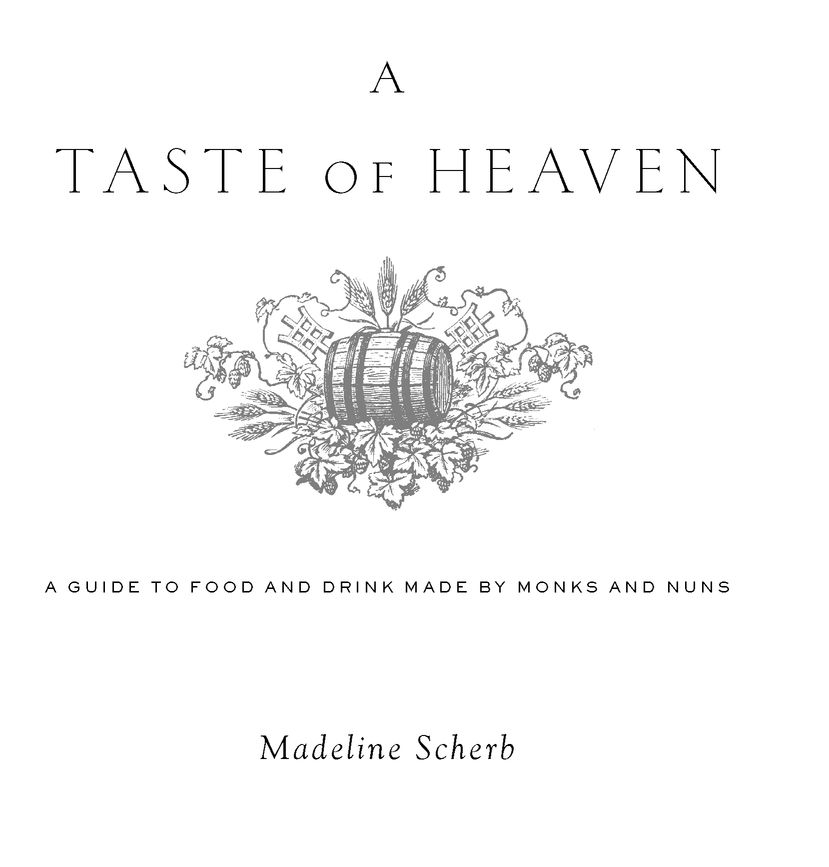Table of Contents
JEREMY P. TARCHER/PENGUIN
a member of Penguin Group (USA) Inc.
New York
For my parents, Frank and Margarita Scherb,
and in loving memory of Brother Raphael Prendergast, OCSO,
Abbey of Gethsemani
FOREWORD
They are truly monks when they live by the labor of their hands, as did our fathers and the apostles.
RULE OF SAINT BENEDICT, CHAPTER 48
Food should be treated with respect since Our Lord left himself to us in the guise of food.
DOROTHY DAY
The early monks supported themselves by the work of their hands, usually weaving mats, hats, rugs, baskets, and other products that they later sold at nearby local markets. Work is an integral part of all human life, be it inside or outside a monastery. Therefore, monks seriously apply themselves to the humble task of earning their living, not wishing to beg or be a burden to anyone.
What differentiates the monks approach to work from that of others is the attitude he brings to it. Monastic work is functional. It is not motivated by a desire for a career or for success, and even less by greed. The first function of monastic work is that it be in the imitation of Jesus and Saint Joseph, the humble carpenters of Nazareth. Along with Mary, they give us an example of how to live and order the pattern of our lives. The second function of monastic work is to provide for the monastery and those who inhabit it. The third important aspect of all monastic work is the element of balance that work brings to the daily rhythm of monastic life.
A Taste of Heaven is the result of a personal monastic pilgrimage. It gives the reader a glimpse into the unique life of some of the most remote monasteries of both Europe and the United States. The book tells the tale of the histories, practices, and artisanal products of these monasteries and explores the stories of the monks and nuns who live, work, and worship within their walls. It reads like a virtual tour of these places of profound silence. Its pages, filled with gentle anecdotes particular to each monastery or monastic figure, should be read quietly, as a form of guided meditation.
The author also does all of us a great service by making available an exquisite collection of recipes derived from various monasteries. These recipes have as their source the many different products traditionally made by monks and nuns: cheese, ales, wines, liqueurs, olive oil, chocolates, vinegars, tapenades, herbs, candies, and baked goods. In following these recipes and making use of these products, we discover the secret character of monastic cookery: a cuisine known for its simplicity, sobriety, and basic good taste. Individuals such as the author who have partaken in the gracious hospitality of the monasteries mentioned in this book can attest to the healthy, balanced diet practiced by monks and nuns. In most cases the food presented at the monastery table consists of products from the monastery farms and gardens, coupled with local produce prepared with a great deal of love and presented with simplicity. Such simplicity need not preclude elegance; in fact, monks and nuns believe that simplicity itself is synonymous with elegance.
I trust the reader will be inspired by the beautiful stories in this book to discover the products made not only by the monasteries mentioned here, but also by those monasteries located closer to their homes. Many monasteries, including ours, sell their products at local farmers markets or at annual festivals, such as our Summer Vinegar Festival and Christmas Fair. People appreciate having these products made readily available to them. These days they can even be purchased online. Whatever the case, the reader contributes directly to the livelihood of monasteries by appreciating and purchasing their products. May this always be, so that, in Saint Benedicts words, God may be glorified in all things.
BROTHER VICTOR-ANTOINE DAVILA-LATOURRETTE
November 13, 2008
Feast of All Monastic Saints
La Grangeville, New York
INTRODUCTION
Bells are the heartbeat of abbey life. They call the community to prayer throughout the day. They can be loud or soft, joyful or soulful. A new bell becomes part of the monastic family in a kind of bell baptism: it is blessed and is sometimes named after a saint. When the monks of Stift Heiligenkreuz in Austria recently climbed the pop charts with their recordings of chant, they even included the abbeys bells in between songs.
However, a guest who stays at an abbey overnight may feel something other than love for the bell that tolls around three a.m. for Vigils, the first prayer service of the day. This is especially true at Gethsemani Abbey in Kentucky, where the formidable bell can make a bleary-eyed guest feel like one has been tied to the clapper in a plot invented by Charlie Chaplin.
Some monastery guests have trouble getting up for Vigils, but the monks and nuns are used to it. Many of them describe Vigils as a peaceful way to begin the day and to prepare for work. Perhaps thats why food made by monks and nuns tastes heavenly. Another likely reason is that the balance between prayer and work at a monastery is, as one French monk enthusiastically puts it, merveilleux, merveilleux! Simply marvelous. Monks and nuns live to pray, not to work.
Meanwhile, at three a.m. in the secular world most people are still fast asleep. Their day holds little promise of prayer or song, unless the former is for a raise and the latter occurs in the shower. Its difficult to find balance on any given day, and all too often people feel like they live to work.
What can the rest of us learn from the way monks and nuns live and the exceptional products they make? It isnt just that they pray seven times a day, prefer silence, and shun TV (all things that secular folks can also do), or that they choose to serve God in a monastic community rather than raise a family. Their life is also defined by a specific rule of conduct. One of the earliest monastic rules was the Rule of Saint Benedict, written in the sixth century. Prayer, work, and spiritual reading remain the pillars of Benedictine monastic life to this day.
Benedict places importance on singing the Divine Office above all else but also instructs monks to work, saying, He who lives by the work of his own hands is truly a monk. (The famous Abbey of Cteaux prints a variation on Benedicts dictum, Prire & Travailprayer and workon the label of its eponymous cheese.) Manual labor is important for monks not only because they are following in the footsteps of the Apostles and Jesus, who was a carpenter, but also because Benedict warns that idleness is the enemy of the soul.
Monks and nuns must earn enough to sustain their abbeys, but they never strive to make money for moneys sake. They are also immune from the constant pressure to make shareholders richer. When the monks at Westmalle Abbey recently chose to cap production of their world-renowned beer despite increasing demand, they made a decision that was as unlikely in corporate America as it would be for an incompetent manager to confess his faults. Monks and nuns work just enough to support their monasteries while some, such as Westmalle, use surplus profits for charity.
The work that monks and nuns do is intertwined with the monastic way of life; one cant be separated from the other. Monks and nuns see the earth as Gods creation and each living thing as part of that creation. They see Gods love for us in the beauty of this creation rather than in manmade thingsthe fancy homes, luxury cars, expensive clothes, fame, and fortune that some folks crave. When they rise for prayer before dawn they are participating in Gods creation. When they sing the Psalms they are doing the same. When they make caramels, cheese, beer, chocolate, jam, and other marvelous foods, they are creating something special that makes the world a better place. Their work is essentially a form of sharing Gods love with the rest of us.





